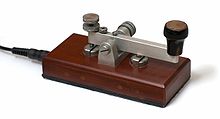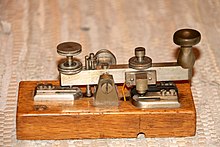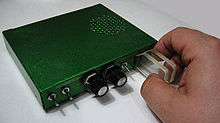Morse key
A morse key is used to enter morse code . There are different types of construction that differ in terms of the technical complexity, manual delivery technique and the maximum possible delivery speed.

Hand button

The hand key is the oldest Morse code key and has been the telegraphist 's most important tool since the invention of telegraphy. From an electrical point of view, it is just a button . The oldest manual keys were levers on telegraphs . They were used to probe direct current, which was converted into dots and lines on paper tapes.
In the early days of wireless Morse code from around 1900, series of sparks were sensed (see pop-spark transmitters ), the high-frequency components of which were converted into audible signals with detector receivers . The keys for this were called telegraph keys .
In Germany, from 1926, the manual key ( Junker Morsetaste MT ) patented by the former sea captain Joseph Junker , which was one of the few classic morse keys still in production until 2014, spread.
The spring pressure as well as the distance between the contacts of the hand button are adjustable. The possible typing speed is relatively low (around 80-100 letters per minute). As practice increases, it lags behind the reading speed. The keying is done vertically with four fingers, which hold the button on the touch lever, with the elbow resting on the table and the wrist very loose. If the spasms persist, tendinitis can develop, similar to playing keyboard instruments . Without a strong sense of rhythm on the part of the encoder, the intelligibility of Morse code is limited. On the other hand, when using manual buttons, a personal style of the radio operator can be recognized.
Semi-automatic button
Semi-automatic keys produce the "dots" of a Morse code almost automatically, with mechanical keys with an oscillating spring. The "lines" have to be measured manually. Most keys are keyed horizontally (left-right with thumb and forefinger) and are physically considerably less strenuous. Therefore, the possible delivery speed is greater.
The reason for the development of the semi-automatic Morse code key was the carpal tunnel syndrome (comparable to a " tennis elbow "), which after about 10 to 15 years led to the telegraphist being unable to work after thousands of daily up and down movements of the probe arm. The best American tactile operator around 1895, Horace G. Martin, noticed that he was beginning to suffer from carpal tunnel syndrome and developed the semi-automatic button. Initially designed as an electromechanical button, it was not a sales success due to the very expensive battery required for operation.
William O. Coffe applied for a patent for the mechanical bow in 1904.
The immediate successor to this key, the first Vibroplex encoder, established itself within a very short time. It not only enabled faster sending and thus higher earnings (words were paid per minute), but also less tiring giving and a significant relief of the touch arm.
Horace Martin applied for his patent for the Vibroplex in 1904, and the keys were produced in series from 1905. His first Vibroplex model "Original" has been built almost unchanged to this day. Thankfully, Horace Martin has consistently numbered most of his keys so that it is still possible to determine exactly when which key was built. The earliest known surviving Vibroplex bears the serial number 7.
Even before the semi-automatic machine came on the market, a bad telegraph operator was called a bug (bug, beetle) in the USA. Since the telegraph operators at the time initially sent messy messages with the new Vibroplex buttons, the name "bug" was quickly transferred to the button. From around 1920, Vibroplex first introduced the Beetle on stickers and then on its “new” brass-colored label as a trademark.
Keys were also developed that "automatically" generated not only the dot but also the stroke of the Morse code with the help of a pen (according to the invention of Melvin E. Hanson, manufactured by Melehan Radio). However, this happened at a time when the first electronic encoders were coming onto the market.
Today only a few companies manufacture semi-automatic Morse code keys. Today, GHD from Japan is a technical leader and, in addition to manual buttons and "semi-automatic machines", also builds a "fully automatic machine".
The term "bug" was later transferred to automatic keys with electronic line and dot generation: Elbug (electronic bug).
Automatic button
Automatic keys ( wobblers , also called Elbug , with one or two levers) produce both sequences of dots and lines of the correct length. The keying is also done horizontally. The achievable transmission speed is much higher than with the manual key.
With the squeeze technique, the speed can be increased even further: when you press both levers together, alternating points and lines are given. Skillful use of this behavior reduces the number of finger movements required.
The control electronics for automatic keys are either integrated into the housing of the key or already built into the radio .
Another option without control electronics is to connect the button in series with a voltage source to a serial computer interface. A computer program then generates the dots and lines with which the radio device is controlled - again via the serial interface or USB.
Software solutions
Morse code signals can also be generated with the aid of computer programs which encode the text entered via a keyboard as Morse code. This has only the code in common with the original Morse code. It is refused by many radio operators.
Modern applications
Morse code decoding software solutions have enabled Morse code keys to replace the standard computer keyboard. Physically handicapped people are thus able to operate computers (and also, for example, amateur radio systems ) independently. If necessary, special keys or body sensors are also used for this.
literature
- Gregor Ulsamer: The fascination of Morse code keys. German Telegraph Keys. Collector's Guide. Self-published, Emden 2001, ISBN 3-00-014965-1 .
Web links
- Views and descriptions of other morse keys
- DK5KE Morse code Notes on keys, settings and commands
- Collection of German morse keys
Individual evidence
- ↑ Winfried Ciolek: Morse code 1,2,3, German Amateur Radio Club. From DARC.de, accessed December 7, 2019.
- ↑ U.S. Patent 812,183
- ↑ U.S. Patent 2,329,531
- ↑ elbug
- ↑ see corresponding links in "GNU / Linux accessibility package"



